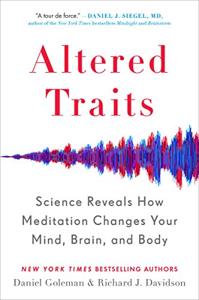
Want to learn the ideas in Altered Traits better than ever? Read the world’s #1 book summary of Altered Traits by Daniel Goleman, Richard J. Davidson here.
Read a brief 1-Page Summary or watch video summaries curated by our expert team. Note: this book guide is not affiliated with or endorsed by the publisher or author, and we always encourage you to purchase and read the full book.
Video Summaries of Altered Traits
We’ve scoured the Internet for the very best videos on Altered Traits, from high-quality videos summaries to interviews or commentary by Daniel Goleman, Richard J. Davidson.
1-Page Summary of Altered Traits
Overview
It’s easy to be skeptical about meditation, but it actually has scientific value. The authors cite numerous studies that prove how meditation can help you become a better person, and they’ll explain why this is the case. We’ll learn about specific parts of the brain affected by meditative practices and how to use them for our own benefit.
The benefits of meditation are available to everyone, even those who have never meditated before. You’ll learn that multitasking isn’t helpful and how to deal with a wandering mind when you’re meditating.
Big Idea #1: Two types of meditation include focusing on a singular thing and not reacting to thoughts.
A Harvard graduate student named Goleman went to India to study meditation. There are many different types of meditation, but he was advised by one teacher to learn about a type called “mindfulness,” which focuses on being aware of your surroundings and the present moment. It’s part of Buddhism, which is widespread in Southeast Asia.
When you begin meditation, it’s hard to focus on one thing because your mind is all over the place. However, with practice, your thoughts will calm down and you’ll be able to concentrate on just one thing—your breathing.
Meditation is an important aspect of Buddhism. The founder, Gautama Buddha, lived during the 6th century BC. There are two types of meditation: one that focuses on not reacting to thoughts and another that encourages you to pay attention to them. With practice, both will help you develop equanimity – a state where your core consciousness remains unaffected by passing thoughts.
It doesn’t matter what type of meditation you do, as long as it helps you. The main thing to consider is which one will help you the most and how to get started.
Big Idea #2: Meditation reduces reactions to emotional cues and stress triggers.
Imagine you’re in a job interview and the interviewer asks you to do some math problems. You try to prove yourself as valuable, but the interviewer doesn’t seem interested in what you have to say. He or she then asks you to subtract 17 from 1324 repeatedly without making any mistakes at all.
This is a psychological test that calculates participants’ reactions to stressful social situations. Their heart rates and blood pressure are measured to determine how they react.
Meditation is one way to help people become less sensitive to triggers. Researchers found that after exposure to the Trier Social Stress Test, teachers recovered from stress more quickly if they’d practiced meditation. In fact, the longer they meditated, the faster their recovery time and it was effective even five months later.
In 2016, Davidson replicated the Ekman and Wallace study in his lab. He added experienced meditators to the group of non-meditators. After eight hours of meditation on day one, they took the Trier test on day two. The results showed that those who had meditated produced less stress hormone than those who hadn’t meditated. Moreover, they didn’t find the Trier test particularly stressful.
Meditation can help you become less sensitive to emotional cues. In 2017, Davidson continued his work with experienced meditators by using a scanner to observe their brain activity while they looked at images of injured and suffering people.
A study was done to analyze the amygdala, which is the part of the brain that deals with emotional processing. The researchers found that meditators had a stronger connection between their amygdalas and prefrontal cortexes than non-meditators did. This strong connection lessens the effect of strong emotions on people.





